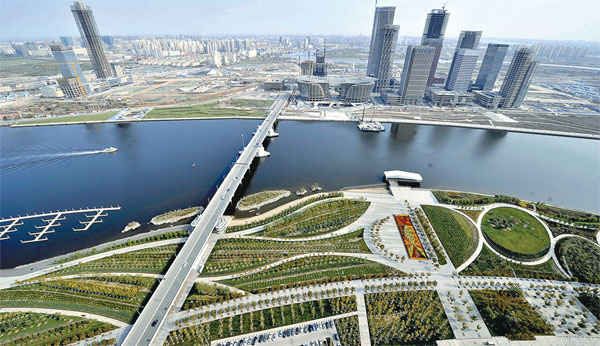Green buildings in place
Low-carbon model town set to promote eco-friendly living
Eight out of 120 high-rise environmentally friendly buildings are expected to be completed by mid-2015 in the Yujiapu Financial District, as part of an APEC Low-Carbon Model Town located away from the built-up city area.
Each square meter of the buildings, which are located in a tulip-shaped green enclave with a river, is expected to reduce carbon dioxide emissions by 10 kg a year, said Mu Lingling, CEO assistant of the Tianjin Innovative Finance Investment Co Ltd. There are also plans for similar effects for all of the new construction projects in the district by 2024.
The Yujiapu Financial District, located in the northern Chinese coastal city of Tianjin, is a 3.86-square-kilometer demonstration area approved by the APEC leaders in 2010 for developing the practices needed to achieve low-emissions urban communities.
A series of measures are being carried out to promote eco-construction through environmental planning, green architectural design as well as the optimization of construction techniques.
Energy consumption can be effectively reduced by constructing green buildings, said Mu, whose company is in charge of the district's overall planning, low-carbon facility construction and business promotion with the approval of the Tianjin government.
"The green building is a technology-intensive sector. At the very beginning of the design process, our architectural engineers already included the low-emission concept in their drafts, following international guidelines such as the American LEED," said Yang Haisong, assistant manager of the company.
Apart from utilizing basic eco-facilities such as a solar-powered waste disposal and recycling system, Yang said, the district also implements energy-efficient buildings through integrated land use planning coupled with various energy-saving technologies.
Tianjin has imposed requirements covering energy efficiency in its 12th Five-Year Plan (2011-15). The transportation sector has been classified as one of the three major drivers of the city's energy consumption. The other two are the industrial and building sectors.
Yujiapu Financial District has further developed this principle through its underground transport network. The network includes three underground floors, and the lowest two contribute to the district's 3D transportation system made up of buses, light rail, taxis and bicycles.
The transport network has been built into a cube-like hub. The residents who live in the district can walk to the bus station within 250 meters. More than two kinds of public transport can be interchanged within the 200-meter radius.
"Our area coverage rate of rail transit services has reached more than 80 percent in the 3.86-square-kilometer area. That means that residents barely need to drive cars in the district," Yang said.
The idea behind the design is to improve land use and develop the facilities' connectivity for reducing unnecessary carbon dioxide emissions both from passengers and transit, and link businesses with the downtown and surrounding areas.
The essence of low-carbon communities is to seek energy-efficient and clean development to realize economic transformation and green GDP, Mu said.
The Proposal on Establishment of the APEC Cooperation Network on Green Supply Chain, which is an evolving cooperation mechanism for promoting the green trade and investment and the environmental communication in the Asia-Pacific region, recently received support on the 2014 APEC High-Level Roundtable on Green Development on May 8 in Tianjin.
The leaders at the meeting discussed the importance of expanding green growth in the economies.
Lyu Shuang contributed to the story.
zhangmin@chinadaily.com.cn
|
Yujiapu Financial District of Tianjin has been making great efforts to develop low-emissions urban communities. Yue Yuewei / Xinhua |
(China Daily 11/10/2014 page35)















